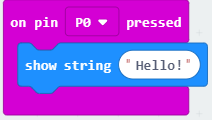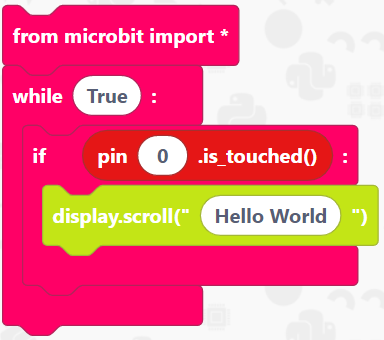This week we will take a look at what we can do with the General Purpose Input Output (GPIO) pins. You can do a lot of things using the pins at the bottom of the micro:bit including using touch, connecting them to tinfoil, fruit, headphones or other electronic components using crocodile clips. You can even use them with add-on boards like motor controllers, LED screens and more.
MakeCode
- open MakeCode within your favourite browser
- Click on the on start block and drag it to the left and drop it in the bin. Do the same for the forever block
- Click on Input Click and drag a on p0 pressed block to the code area and drop it
- Click on Basic Click and drag a show string “Hello!" block to the code area and attach it within the on p0 pressed block
Your code is now complete and ready to download to your micro:bit.
NOTE: You can use this code different ways. You can just hold the GND pin and press pin 0 or you can glue some tinfoil to cardboard and connect the pins with crocodile clips.
Completed Code

EduBlocks
- Open EduBlocks within your favourite browser
- Click on Basic Click and drag a from microbit import * block to the code area and drop it
- Click on Basic Click and drag a while True: block to the code area and attach it under the from microbit import * block
- Click on Basic Click and drag a if True: block to the coding area and attach it within the while True: block
- Click on Pins Click and drag a pin 0.is_touched() block to the code area and attach it where it says True in the if block
- Click on Display Click and drag a display.scroll(“Hello World”) block to the code area and attach it within the if pin 0.is_touched() block
Your code is now complete and read to download to your micro:bit and try out.
Completed Code

Python
- Open your favourite Python editor to use with the micro:bit
- Type
from microbit import *This imports the Python library for micro:bit so we can now interact with the micro:bit - Type
while True:This creates a loop that will carry on while the conditions are true - Type
if pin0.is_touched:Creating a condition on pin 0, so when pin 0 is touched - Type
display.scroll("Hello World!")When pin 0 is touched Hello World! will scroll across the LED display.
Your code is now complete and ready to try out.
Completed Code
from microbit import *
while True:
if pin0.is_touched:
display.scroll("Hello World!")
Conclusion
That’s it for this week. Come back next Monday where we will dig into the pins a little bit deeper and create a simple robot.